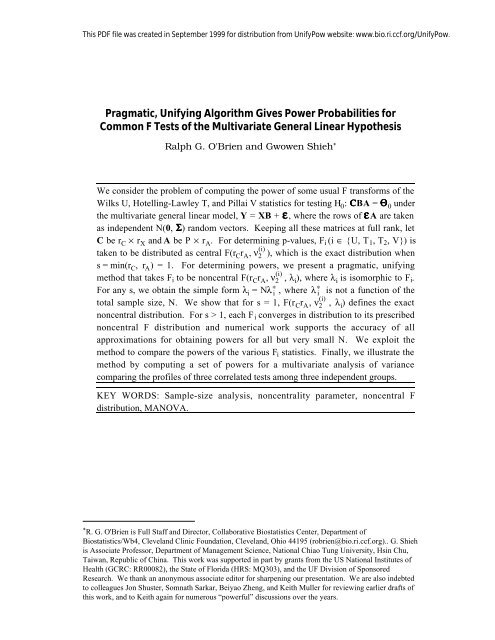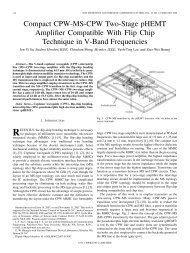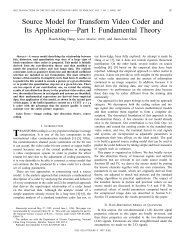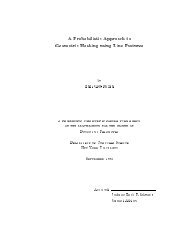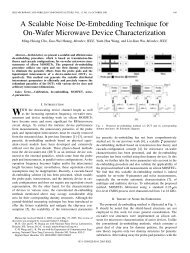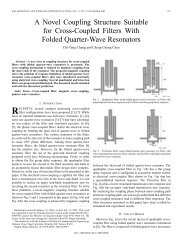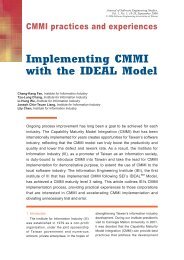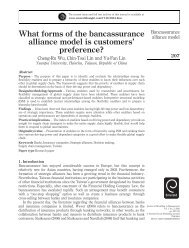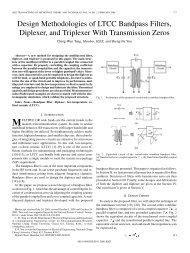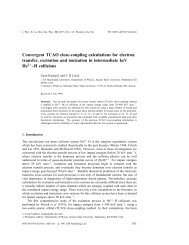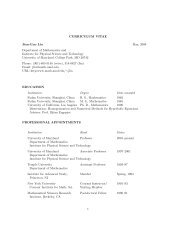Pragmatic, Unifying Algorithm Gives Power Probabilities for ...
Pragmatic, Unifying Algorithm Gives Power Probabilities for ...
Pragmatic, Unifying Algorithm Gives Power Probabilities for ...
You also want an ePaper? Increase the reach of your titles
YUMPU automatically turns print PDFs into web optimized ePapers that Google loves.
This PDF file was created in September 1999 <strong>for</strong> distribution from UnifyPow website: www.bio.ri.ccf.org/UnifyPow.<br />
<strong>Pragmatic</strong>, <strong>Unifying</strong> <strong>Algorithm</strong> <strong>Gives</strong> <strong>Power</strong> <strong>Probabilities</strong> <strong>for</strong><br />
Common F Tests of the Multivariate General Linear Hypothesis<br />
Ralph G. O'Brien and Gwowen Shieh *<br />
We consider the problem of computing the power of some usual F trans<strong>for</strong>ms of the<br />
Wilks U, Hotelling-Lawley T, and Pillai V statistics <strong>for</strong> testing H 0 : CBA = Π0 under<br />
the multivariate general linear model, Y = XB + ‰, where the rows of ‰A are taken<br />
as independent N(0, Í) random vectors. Keeping all these matrices at full rank, let<br />
C be r C × r X and A be P × r A . For determining p-values, F i (i ∈ {U, T 1 , T 2 , V}) is<br />
taken to be distributed as central F(r C r A , ν (i)<br />
2 ), which is the exact distribution when<br />
s = min(r C , r A ) = 1. For determining powers, we present a pragmatic, unifying<br />
method that takes F i to be noncentral F(r C r A , ν (i)<br />
2 , λ i ), where λ i is isomorphic to F i .<br />
For any s, we obtain the simple <strong>for</strong>m λ i = Nλ ∗ i , where λ ∗ i is not a function of the<br />
total sample size, N. We show that <strong>for</strong> s = 1, F(r C r A , ν (i)<br />
2 , λ i ) defines the exact<br />
noncentral distribution. For s > 1, each F i converges in distribution to its prescribed<br />
noncentral F distribution and numerical work supports the accuracy of all<br />
approximations <strong>for</strong> obtaining powers <strong>for</strong> all but very small N. We exploit the<br />
method to compare the powers of the various F i statistics. Finally, we illustrate the<br />
method by computing a set of powers <strong>for</strong> a multivariate analysis of variance<br />
comparing the profiles of three correlated tests among three independent groups.<br />
KEY WORDS: Sample-size analysis, noncentrality parameter, noncentral F<br />
distribution, MANOVA.<br />
* R. G. O'Brien is Full Staff and Director, Collaborative Biostatistics Center, Department of<br />
Biostatistics/Wb4, Cleveland Clinic Foundation, Cleveland, Ohio 44195 (robrien@bio.ri.ccf.org).. G. Shieh<br />
is Associate Professor, Department of Management Science, National Chiao Tung University, Hsin Chu,<br />
Taiwan, Republic of China. This work was supported in part by grants from the US National Institutes of<br />
Health (GCRC: RR00082), the State of Florida (HRS: MQ303), and the UF Division of Sponsored<br />
Research. We thank an anonymous associate editor <strong>for</strong> sharpening our presentation. We are also indebted<br />
to colleagues Jon Shuster, Somnath Sarkar, Beiyao Zheng, and Keith Muller <strong>for</strong> reviewing earlier drafts of<br />
this work, and to Keith again <strong>for</strong> numerous “powerful” discussions over the years.
O'Brien and Shieh: <strong>Power</strong> <strong>for</strong> the Multivariate Linear Hypothesis<br />
1. INTRODUCTION<br />
Hypothesis-driven research proposals now typically include power analyses to<br />
support the chosen design and sample size. Doing so promotes an early fusion of the<br />
study's research questions, its proposed design, the specific measures to be collected, and<br />
the prescribed data analyses. Of course, the power analyses should be congruent with the<br />
stated hypotheses and their prescribed tests. It is our experience, however, that power<br />
analyses <strong>for</strong> multivariate hypotheses often use only oversimplified, univariate surrogates.<br />
For example, a proposed multivariate analysis of variance of a factorial design might be<br />
supported only by a power analysis based on some univariate, two-group t tests of the<br />
individual measures. Such incongruence weakens the statistical plan and hurts the quality<br />
of the entire proposal.<br />
Herein we propose and assess a pragmatic strategy <strong>for</strong> computing the powers of<br />
specific Normal-theory hypothesis tests under the multivariate general linear model.<br />
Section 2 briefly reviews the noncentrality <strong>for</strong> the univariate general linear model and<br />
then extends it to specify approximate (sometimes exact) noncentral distributions <strong>for</strong> the<br />
common F trans<strong>for</strong>ms of the Wilks, the Hotelling-Lawley, and the Pillai statistics. Our<br />
method is a modification of and is asymptotically equivalent to the Muller-Peterson<br />
(1984) algorithm discussed in Muller, LaVange, Ramey, and Ramey (1992). But unlike<br />
their method, ours provides the exact noncentral F distribution whenever the hypothesis<br />
involves at most s = 1 positive eigenvalue of E –1 H. For s > 1, both methods designate<br />
approximate noncentral F distributions that converge (N → ∞) well to their limiting<br />
<strong>for</strong>ms. But as the Monte Carlo work in Section 3 illustrates, our method is almost always<br />
more accurate than the Muller-Peterson, and it is sufficiently accurate <strong>for</strong> per<strong>for</strong>ming<br />
power analyses. In Section 4 we use the method to characterize how the relative powers<br />
of the F statistics are dependent on the structure of the s eigenvalues of the population<br />
version of E –1 H. Section 5 focuses on the common q-group, P-variate problem, and<br />
outlines an example.<br />
2
O'Brien and Shieh: <strong>Power</strong> <strong>for</strong> the Multivariate Linear Hypothesis<br />
2. NONCENTRALITIES<br />
Consider the standard (fixed-effects), full-rank multivariate general linear model, Y<br />
= XB + ‰, where Y is N × P of rank P; X is N × r X of rank r X ; and B contains fixed<br />
coefficients. The rows of ‰ are taken to be independent P-variate Normal random vectors<br />
with mean 0 and P × P positive-definite covariance matrix Í. The usual estimates are<br />
Bˆ = (X′X) –1 X′Y, and ͈ = (Y – XBˆ )′(Y – XBˆ )/(N – r X ). The multivariate general linear<br />
hypothesis is H 0 : CBA = Œ 0 , where C is r C × r X with full row rank, and A is P × r A with<br />
full column rank; thus r A ≤ P. Œ 0 is usually chosen to be 0. H 0 has ν 1 = r C r A degrees of<br />
freedom.<br />
2.1 r A = 1<br />
If r A = 1 so that A ≡ a, the problem simplifies to a univariate one with y ≡ Ya =<br />
XBa + ‰a = X∫ + ‰. The resulting estimates are ∫ˆ = Bˆ a and σˆ 2 = a′͈ a/(N – r X ) . H 0<br />
is tested with F = (SSH/r C )/σˆ 2 , where<br />
SSH = (C∫ˆ – Œ 0 )′[C(X′X) -1 C′] -1 (C∫ˆ – Œ 0 )<br />
is the sums of squares <strong>for</strong> the hypothesis. It is well-known that F is distributed as an<br />
F(ν 1 , ν 2 , λ) random variable with ν 1 = r C and ν 2 = N – r X degrees of freedom and<br />
noncentrality<br />
λ = (C∫ – Œ 0 )′[C(X′X) -1 C′] -1 (C∫ – Œ 0 )/σ 2 .<br />
It is helpful to see (X′X) -1 decomposed into more distinct components. Letting 1 be<br />
the N × 1 vector of ones, then x – = N -1 X′1 is the r X -element mean vector and S X =<br />
N –1 (X – 1x – ′)′(X – 1x – ′) is the corresponding r X × r X covariance matrix. Then X′X =<br />
N(S X + x –– x ′ ) = NÁ, showing that with respect to X′X, the size of the design (N) is<br />
unrelated to Á, which is only dependent on the means, variances, and correlations of the<br />
Xs. Thus, [C(X′X) -1 C′] -1 = N[CÁ -1 C′] -1 , so<br />
λ = Nλ ∗ = N{(C∫ – Œ 0 )′[CÁ -1 C′] -1 (C∫ – Œ 0 )/σ 2 }. (2.1)<br />
3
O'Brien and Shieh: <strong>Power</strong> <strong>for</strong> the Multivariate Linear Hypothesis<br />
2.2 General Strategy <strong>for</strong> r A > 1<br />
For r A > 1, SSH generalizes to the r A × r A sums of squares and cross products matrix<br />
<strong>for</strong> the hypothesis,<br />
H = N(CBˆ A – Œ 0 )′[CÁ -1 C′] -1 (CBˆ A – Œ 0 ).<br />
σˆ 2 generalizes to A′͈ A = E/(N – r X ), where E = A′(Y – XBˆ )′(Y – XBˆ )A. H and E are<br />
independent Wishart matrices, both based on A′Í A, and having r C and N – r X degrees of<br />
freedom, respectively. (SSH/r C )/σˆ 2 generalizes to {(N – r X )/r C }E -1 H, but by tradition<br />
we work with E -1 H.<br />
There is no generally optimal way to map E -1 H to a univariate test statistic. The<br />
most common ones are the Wilks Likelihood Ratio (U), Hotelling-Lawley Trace (T), and<br />
Pillai Trace (V) statistics, which are reviewed below. All are based on the s = min(r C , r A )<br />
positive eigenvalues of E -1 H, denoted ƒ = {φ 1 , ..., φ s }, and ordered φ 1 > φ 2 > … > φ s > 0.<br />
U, T, and V are summarized and compared by Seber (1984), Anderson (1984), and<br />
numerous other books and articles, and their critical values have been widely tabled and<br />
charted (e.g., Seber, pp. 562-564). But in practice we usually obtain p values by<br />
trans<strong>for</strong>ming them to F-type statistics, denoted here as F i , i ∈ {U, T 1 , T 2 , V}. If r C = 1,<br />
each F i becomes F = (N – r X – r A + 1)φ 1 /r A , which is also an exact F random variable, as<br />
discussed below. For s > 1, the F i statistics are distinct, having different ν 2 (i) and λ i .<br />
We do not propose or study power approximations <strong>for</strong> Roy's test. For s > 1, no<br />
acceptable method has been developed <strong>for</strong> trans<strong>for</strong>ming φ 1 to an F or χ 2 statistic. No<br />
straight<strong>for</strong>ward method exists <strong>for</strong> computing powers <strong>for</strong> Roy's statistic itself (Anderson,<br />
1984, pp. 332), although various approximations have been developed, as reviewed by<br />
Krishnaiah (1978). Roy's statistic is fundamentally different from U, T, and V, thus its<br />
power is not accurately discerned from the power probabilities computed <strong>for</strong> F U , F T1<br />
, F T2<br />
and F V .<br />
E –1 H = (E/N) –1 (H/N) = (A′SA) –1 (H/N), where S is the maximum likelihood<br />
estimate of Í. Whereas E is a central Wishart, H is possibly noncentral with<br />
noncentrality matrix<br />
4
O'Brien and Shieh: <strong>Power</strong> <strong>for</strong> the Multivariate Linear Hypothesis<br />
Î = Ν(A′ÍA) –1 (CBA – Œ 0 )′[CÁ -1 C′] -1 (CBA – Œ 0 )}<br />
= N(A′ÍA) –1 H ∗ = NÎ ∗ .(2.2)<br />
H ∗ is the population counterpart of H/N. Let ƒ ∗ = {φ1 ∗ , ..., φ∗ 2 } to be the eigenvalues of<br />
Î ∗ = (A′ÍA) –1 H ∗ , the population counterpart of E –1 H. As N → ∞, Bˆ<br />
→ p B,<br />
H/N → p H ∗ , and E/N → p A′ÍA, so that NE -1 → p (A′ÍA) –1 . Thus, E -1 H → p (A′ÍA) –1 H ∗<br />
and ƒ → p ƒ ∗ .<br />
We shall specify and asymptotically justify all F distributions using a common<br />
notation and logic. First, take F i to be an F random variable with ν 1 = r C r A and ν 2<br />
(i)<br />
degrees of freedom and noncentrality λ i = Nλ ∗ i , a <strong>for</strong>m motivated by (2.1) and (2.2).<br />
Accordingly, E(F i /N) = N -1 (1 + λ i /ν 1 )[ν (i)<br />
2 /(ν (i)<br />
2 – 2)] → λ ∗ i /ν 1 , as N → ∞. Also, <strong>for</strong><br />
each F i , F i /N → p f ∗ i , a constant. This leads to the approximation λ ∗ i = ν 1 f ∗ i . Each f ∗ i is a<br />
function of r C , r A and ƒ ∗ as specified below. Finally, we cite specific theory reviewed by<br />
Anderson (1984, Section 8.6.5) to outline why <strong>for</strong> the Hotelling and Pillai statistics, ν 1 F i<br />
converges to noncentral χ 2 distributions with the noncentralities proposed here. Likewise,<br />
the work of Kulp and Nagarsenker (1984) supports the convergence of ν 1 F U <strong>for</strong> the<br />
noncentral Wilks statistic.<br />
Motivated because E/(N – r X ) is the unbiased estimator of A′ÍA, Muller and<br />
Peterson (1984) proposed extracting the eigenvalues, ƒ (M) , of [(A′ÍA) –1 /(N – r X )][NH ∗ ].<br />
Thus, ƒ (M) =[N/(N – r X )]ƒ ∗ . Furthermore, they proposed making λ (M)<br />
i = ν 2 (i) ν 1 f (M) i ,<br />
where f (M) i uses ƒ (M) just as f ∗ i uses ƒ ∗ . One can easily show that <strong>for</strong> r A = 1 both<br />
methods lead to the exact univariate noncentrality given above. If r A > 1, λ (M)<br />
i < λ i , but<br />
λ i /λ (M)<br />
i → 1 as N → ∞.<br />
Muller and Barton (1989) used a similar strategy to define approximations of the<br />
non-null distributions of F statistics <strong>for</strong> univariate approaches <strong>for</strong> repeated measures<br />
analysis. O'Brien (1986) also applied the strategy to characterize the non-null<br />
distribution of the likelihood-ratio χ 2 statistic commonly used in log-linear models; c.f.<br />
Agresti (1990, Section 7.6.4).<br />
5
O'Brien and Shieh: <strong>Power</strong> <strong>for</strong> the Multivariate Linear Hypothesis<br />
2.3 r A > 1 but r C = 1 (s = 1)<br />
It is well known that when r C = 1, the U, T, and V statistics convert identically to F<br />
= (N – r X – r A + 1)φ 1 /r A , which has r A and (N – r X – r A + 1) degrees of freedom. Our<br />
strategy gives λ = Nφ1 ∗ , where<br />
φ1 ∗ = (CBA – Œ 0 )(A′ÍA) –1 (CBA – Œ 0 )′[CÁ -1 C′] -1 .<br />
This characterizes the exact noncentral F distribution, a result established by first<br />
showing that T 2 = (N – r X )φ 1 is a noncentral T 2 random variable and then converting it to<br />
an exact noncentral F, as per sections 2.4.2 and 2.5.5 of Seber (1984). The result can also<br />
be established by noting that the approximation <strong>for</strong> the distribution of U given by Kulp<br />
and Nagarsenker (1984, Theorem 3.1) is exact <strong>for</strong> s = 1. Its only term then is a<br />
noncentral beta distribution function, which is trans<strong>for</strong>mable to the noncentral F<br />
prescribed here.<br />
With r C = 1, the Muller-Peterson (1984) method gives λ (M) = [(N – r X – r A + 1)/(N – r X )]λ.<br />
For r A > 1, λ (M) < λ. Thus whereas both the proposed method and the Muller-Peterson method<br />
specify the exact noncentral F distribution when r A = 1, only the proposed method properly<br />
handles all s = 1 cases. λ (M) gives powers that are too low, leading to recommended sample<br />
sizes that are too large. This discrepancy between λ and λ (M) is important because many<br />
common situations use r C = 1 and r A > 1, including the one- and two-group Hotelling's T 2 tests<br />
on centroids. We shall see that this difference between λ and λ (M) extends to cases with s > 1.<br />
2.4 r A > 1 and r C > 1 (s > 1)<br />
When s >1, the U, T, and V statistics are distinct and their F trans<strong>for</strong>ms only lead to<br />
approximate noncentral F random variables.<br />
Wilks (F U ). Wilks’ (1932) likelihood ratio statistic is the determinant of E(H + E) –1 ,<br />
s<br />
or equivalently, U = ∏k=1 (1 + φ k ) –1 . Rao's (1951) trans<strong>for</strong>mation is F U =<br />
ν 2 (U) (U –1/t – 1) /(r C r A ), where<br />
t =<br />
⎧<br />
1 r C r A ≤ 3<br />
⎨<br />
⎩{[(r C r A ) 2 – 4]/[r 2 C + r 2 A – 5]} 1/2 r C r A ≥ 4<br />
and ν (U)<br />
2 = t[N – r X – (r A – r C + 1)/2] – (r C r A – 2)/2. When H 0 is true,<br />
6
O'Brien and Shieh: <strong>Power</strong> <strong>for</strong> the Multivariate Linear Hypothesis<br />
F U ~ F(ν 1 , ν 2 (U) , 0), exactly, <strong>for</strong> s = 1 or 2; <strong>for</strong> s > 2, this is an approximation that is<br />
“adequate <strong>for</strong> practical situations” (Seber, p. 41). Using the strategy described above,<br />
F U /N → p f ∗ U = t{(U∗ ) –1/t – 1}/(r C r A ); where U ∗ s<br />
= ∏k=1 (1 + φk ∗ )-1 . Thus we take<br />
λ U = Nλ ∗ U , where λ ∗ U = t{(U ∗ ) –1/t – 1}.<br />
Kulp and Nagarsenker (1984) provided an approximation <strong>for</strong> the noncentral<br />
distribution of U, which quickly provides asymptotic justification <strong>for</strong> our method.<br />
Briefly: As is commonly done (c.f. Anderson, 1984, p. 330), if we take N → ∞ and<br />
CBA → Œ 0 under a sequence of alternatives, then their Theorem 3.1 reduces to a single<br />
noncentral beta distribution function, which is trans<strong>for</strong>mable exactly to the noncentral F<br />
prescribed here. They noted that using the noncentral beta distribution (or, equivalently,<br />
the noncentral F) is better than using the chi-square distribution, as per Sugiura and<br />
Fujikoshi (1969), whose method is not exact under any case, even <strong>for</strong> r A = 1.<br />
For r A > 1, λ U > λ (M)<br />
U . Evidence hereto<strong>for</strong>e that the Muller-Peterson algorithm<br />
systematically under approximates the power of F U comes from a study by Barton and<br />
Cramer (1989). They used λ (M)<br />
U to construct various s > 1 situations with nominal powers<br />
of .80, but reported estimated powers consistently higher than this (based on 5000 trials<br />
of each situation).<br />
Hotelling-Lawley (F T1<br />
, F T2<br />
). Hotelling (1951) and Lawley (1938) proposed the<br />
statistic T = tr[E -1 s<br />
H] = ∑k = 1<br />
φ k . Several F trans<strong>for</strong>ms have been proposed. The most<br />
commonly used one, due to Pillai and Samson (1959), is F T1<br />
= ν (T 1)<br />
2 (T/s) /(r C r A ).<br />
with ν (T 1)<br />
2 = s(N – r X – r A – 1) + 2. McKeon (1974) proposed F T2<br />
= ν (T 2)<br />
2 (T/h) /(r C r A ),<br />
with ν (T 2)<br />
2 = 4 + ( r C r A + 2)g, where<br />
g = (N – r X) 2 – (N – r X )(2r A + 3) + r A (r A + 3)<br />
(N – r X )(r C + r A + 1) – (r C + 2r A + r A<br />
2<br />
– 1)<br />
,<br />
and h = (ν (T 2)<br />
2 – 2)/(N – r X – r A – 1). For s ≥ 2, F T1<br />
/F T2<br />
< 1.00 (with F T1<br />
/F T2<br />
→ 1 as<br />
N → ∞), but this is counterbalanced to some degree by the fact that ν (T 1)<br />
2 > ν (T 2)<br />
2 . We<br />
assessed the difference between F T1<br />
and F T2<br />
<strong>for</strong> 108 cases <strong>for</strong>med by crossing (r A , r C ) =<br />
{(2, 2}, (2, 3}, (3, 2}, (3, 3)}; N – r X = {31, 66, 96}; nominal percentage points <strong>for</strong> F T1<br />
using p T1<br />
= {.005, .010, .020, .040, .050, .075, .100, .200, .400. .600, .800, .900}. We<br />
found that F T1<br />
/F T2<br />
> 0.98; 1.50 < ν (T 1)<br />
2 /ν (T 2)<br />
2 < 1.95; with the ratio of the resulting p<br />
7
O'Brien and Shieh: <strong>Power</strong> <strong>for</strong> the Multivariate Linear Hypothesis<br />
values being 0.666 < p T1<br />
/p T2<br />
< 1.026. Seber (p. 39) stated that when H 0 is true, the F T2<br />
“approximation is surprisingly accurate and supersedes previous approximations”<br />
including F T1<br />
and another by Hughes and Saw (1972). For either F T1<br />
or F T2<br />
, F T /N → p f ∗ T =<br />
T ∗ /(r C r A ), where T ∗ s<br />
= ∑k = 1 φi ∗ . This gives λ T = NT ∗ .<br />
Taking F T1<br />
and F T2<br />
to be noncentral F(r C r A , ν (T 1)<br />
2 , λ T ) and F(r C r A , ν (T 2)<br />
2 , λ T ),<br />
respectively, is supported asymptotically by work summarized by Anderson (1984,<br />
Section 8.6.5) and Seber (1984, Section 8.6d). The asymptotic distribution of (N – r X )T is<br />
χ 2 (r C r A , trÎ = λ T ), again under a sequence of alternatives implying that CBA → Œ 0 as N<br />
→ ∞. χ 2 (r C r A , λ T ) is the limiting <strong>for</strong>m of r C r A F(r C r A , ν 2 , λ T ) as ν 2 → ∞. The asymptotic<br />
distribution of F T1<br />
and F T2<br />
is established simply by noting that (N – r X )T, r C r A F T1<br />
, and<br />
r C r A F T2<br />
all have the <strong>for</strong>m kΤ where k/N → 1, as N → ∞. The fact that ν (T 1)<br />
2 > ν (T 2)<br />
2<br />
implies that nominal powers computed <strong>for</strong> F T1<br />
are uni<strong>for</strong>mly greater than those computed<br />
<strong>for</strong> F T2<br />
.<br />
Comparing λ T to the Muller-Peterson approximation, λ (M)<br />
T 1<br />
= [(N – r X – r A – 1 +<br />
2/s)/(N – r X )]λ T < λ T when r A > 1. Applying the Muller-Peterson strategy to F T2<br />
likewise gives λ (M)<br />
T 2<br />
< λ T .<br />
A reviewer suggested we examine a newer F trans<strong>for</strong>mation, call it F T3<br />
, and the<br />
accompanying power approximation due to van der Merwe and Crowther (1984). F T3<br />
behaves much like F T2<br />
. Across the 108 cases we studied: 1.0001 < F T2<br />
/F T3<br />
< 1.0021;<br />
0.956 < ν (T 2)<br />
2 /ν (T 3)<br />
2 ≤ 0.995 ; 0.997 < p T2<br />
/p T3<br />
< 1.033. In their power approximation, the<br />
main term is identical to using F(r C r A , ν (T 3)<br />
2 , λ T ) as proposed here, and the secondary<br />
term appears to make no practical difference in computing the power. We assessed the<br />
20 cases they evaluated in their Table 3, as well as 54 more cases arising from crossing<br />
(r A , r C ) = {(2, 2), (2, 3), (3, 3)}; N – r X = {31, 66, 96}; nominal power <strong>for</strong> F T1<br />
of π 0 =<br />
{.80, .90}; and eigenvalue structure of Î = {E, G, X} as defined below. The three largest<br />
absolute differences in nominal powers between their method <strong>for</strong> F T3<br />
and our method <strong>for</strong><br />
F T2<br />
were 0.013, 0.012, and 0.010 (all <strong>for</strong> r A = 3, r C = 3, N – r X = 31) with all others less<br />
than 0.010. The average (signed) error was 0.002, and the average absolute error was<br />
0.003. Using only the primary term, their power approximation (equivalent to applying<br />
our general strategy to F T3<br />
) changed the power by at most 0.010. In light of its similarity<br />
to F T2<br />
, we see no reason to study F T3<br />
further.<br />
8
O'Brien and Shieh: <strong>Power</strong> <strong>for</strong> the Multivariate Linear Hypothesis<br />
Pillai (F V ). Bartlett (1939), Nanda (1950), and Pillai (1955) proposed using<br />
V = tr[(E + H) -1 s<br />
H] = ∑k = 1 [φ k<br />
/(1 + φ k<br />
)]. Pillai and Mijares (1959) gave the F trans<strong>for</strong>m,<br />
F V = ν 2 (V)<br />
[V/(s – V)]/(r C r A ), where ν(V) 2 = s(N – r X + s – r A ). F V /N → p f ∗ V =<br />
s[V ∗ /(s – V ∗ )]/(r C r A ), where V ∗ s<br />
= ∑k = 1 [φk ∗ /(1 + φk ∗ )]. Thus we define λ V =<br />
Ns[V ∗ /(s – V ∗ )].<br />
Anderson (1984, Section 8.6.5) summarized results showing that NV → d<br />
χ 2 (r C r A , N trÎ ∗ ), under a sequence of alternatives in which CBA → Œ 0 . To establish that<br />
λ V → N trÎ ∗ , first express NV ∗ = N tr[(I + Î ∗ ) –1 Î ∗ ], where Î ∗ = (A′ÍA) –1 H ∗ . By<br />
recursively using a result in Searle (1982, pp. 151, #16g), N V ∗ =<br />
N tr[Î ∗ – Î ∗2 + Î ∗3 – Î ∗ 4<br />
+ ...] → N trÎ ∗ as Î ∗ → 0 with NÎ ∗ remaining finite. Finally,<br />
λ V = [(NV ∗ ) –1 – (Ns) –1 ] –1 → NV ∗ , because (NV ∗ ) –1 is finite under the sequence of<br />
alternatives, but (Ns) –1 → 0. Similarly, r C r A F V → [(NV) –1 – (Ns) –1 ] –1 → NV. Thus r C r A F V<br />
→ d χ 2 (r C r A , λ V ), and more directly, F V → d F(r C r A , ν 2 (V)<br />
, λ V ).<br />
It can be shown that λ (M)<br />
V ≤ λ V , with equality holding if s = r A and φ1 ∗ = φ2 ∗ = ... =<br />
φs ∗ .<br />
3. ACCURACY<br />
We showed above that when r C = 1 and r A > 1, the proposed method prescribes the<br />
exact noncentral distributions, whereas the Muller-Peterson algorithm prescribes<br />
distributions that are only asymptotically (N → ∞) correct <strong>for</strong> this case. This difference<br />
is important because it applies to many situations found in practice. For example, r A = 3,<br />
r C = 1, r X = 2, and N = 30 defines a two-group discriminant analysis with three variables<br />
and 15 cases per group. If λ = 16.5, the power is exactly 0.90. On the other hand, λ (M) =<br />
15.33, giving a power of 0.875, a 25% error relative to the exact Type II error rate.<br />
For s > 1, both methods are approximate. We now assess such cases.<br />
3.1 Comparison with Results of Lee<br />
Lee (1971) developed an asymptotic <strong>for</strong>mula to approximate the powers <strong>for</strong> U, T,<br />
and V using a complex weighted sum of noncentral χ 2 -distribution functions. He<br />
assessed its accuracy relative to exact values worked out <strong>for</strong> 18 cases in which s = r A = 2,<br />
r C = {3, 5, 9}, and N – r X = 63. Although these results do not strictly apply to assessing<br />
9
O'Brien and Shieh: <strong>Power</strong> <strong>for</strong> the Multivariate Linear Hypothesis<br />
algorithms <strong>for</strong> the power of F U , F T1<br />
, and F V , they offer a convenient place to begin.<br />
Figure 1 gives relative errors of approximation, (π ~ – π)/[π(1 – π)] 1/2 , where ~ π is the<br />
approximated power of F U , F T1<br />
, and F V by either the Muller-Peterson or the proposed<br />
algorithm and π is the exact power of U, T, and V given by Lee. Note that because<br />
[π(1 – π)] 1/2 ≤ 0.50, the relative error is at least twice that of the raw error, π ~ – π.<br />
_______________________________________________________________________<br />
Figure 1. Relative errors of approximation <strong>for</strong> the Muller-Peterson (M-P) and the<br />
proposed methods <strong>for</strong> 18 cases studied by Lee (1971, Table 1). s = r A = 2, r C = {3, 5,<br />
7}, N – r X = 63.<br />
_______________________________________________________________________<br />
The two F-based methods show accuracies that are quite acceptable <strong>for</strong> per<strong>for</strong>ming<br />
power analyses of proposed studies. For these cases, they give relative errors within<br />
±3%, with averages much less than that. The proposed method is seen to be biased<br />
positively <strong>for</strong> U and T 1 . As hypothesized above, the Muller-Peterson shows a tendency<br />
to underestimate power, but its overall accuracy seems slightly superior to the proposed<br />
method in these cases. We per<strong>for</strong>med similar computations based on Lee's Table 2 and<br />
found the same pattern <strong>for</strong> s = r A = {3, 4} as we did <strong>for</strong> s = r A = 2.<br />
This encouraging assessment is limited in two respects. First, like other researchers<br />
of this topic, Lee was not concerned with methods <strong>for</strong> computing the power probabilities<br />
of F U , F T1<br />
, and F V , which are the test statistics generally used today. The powers of (say)<br />
U and F U surely diverge <strong>for</strong> lower N, though perhaps only slightly. As a practical matter,<br />
we would prefer an algorithm that gives more accurate powers <strong>for</strong> F U to one that gives<br />
more accurate powers <strong>for</strong> U. Second, the cases Lee created to investigate had powers<br />
much lower than are typically of interest. The largest power is 0.62, with the vast<br />
majority being less than 0.50. For problems of sample-size choice, one generally desires<br />
to have nominal powers of 0.80 or higher. We prefer 0.90.<br />
3.2 Monte Carlo Study<br />
For the reasons just stated, we per<strong>for</strong>med a Monte Carlo study to assess how well we<br />
can compute the power of F U , F T1<br />
, F T2<br />
, and F V directly, <strong>for</strong> situations with meaningful<br />
10
.<br />
0.03<br />
0.02<br />
Relative Error of Approximation<br />
0.01<br />
0.00<br />
-0.01<br />
-0.02<br />
-0.03<br />
M-P<br />
Proposed<br />
M-P<br />
Proposed<br />
M-P<br />
Proposed<br />
F U<br />
F T1<br />
F V<br />
Figure 1.
O'Brien and Shieh: <strong>Power</strong> <strong>for</strong> the Multivariate Linear Hypothesis<br />
power, π ≥ .80.<br />
Method and design. Because F T1<br />
has the simplest proposed nominal noncentral<br />
distribution, we used this to specify the particular non-null cases to simulate. For a given<br />
N, r X , r C , and r A , and a given nominal power, π T1<br />
= π 0 , we employed the SAS ® functions<br />
FINV and FNONCT to find λ 0 such that Prob[F(r C r A , ν (T 1)<br />
2 , λ 0 ) > F .05 (r C r A , ν (T 1)<br />
2 , 0)] =<br />
π 0 . For s > 1, we defined four different structures <strong>for</strong> the first s eigenvalues of Î ∗ , ƒ ∗ =<br />
{φ1 ∗ , φ2 ∗ ,..., φs ∗ }:<br />
Equal (E): ƒ ∗ = (λ 0 /N)s –1 {1, 1, ..., 1}<br />
Linear (L): ƒ ∗ = (λ 0 /N)[s(s + 1)/2] –1 {s, s – 1, ..., 1}<br />
Geometric (G): ƒ ∗ = (λ 0 /N)(2 s – 1) –1 {2 s-1 , 2 s–2 , ..., 1}<br />
Extreme (X): ƒ ∗ = (λ 0 /N){1, 0, ..., 0}.<br />
The sum of the roots, T ∗ = λ 0 /N, is the same <strong>for</strong> all four structures; thus, λ T = λ 0 ,<br />
and the nominal power <strong>for</strong> F T1<br />
is π 0 . Though lower than π 0 , the nominal power <strong>for</strong> F T2<br />
is<br />
also the same under all four structures. On the other hand, λ U and λ V are affected by the<br />
structure of the eigenvalues. To keep π 0 fixed, the elements in ƒ ∗ must decrease with<br />
increasing N.<br />
We examined all four F statistics under the E, L, G, and X structures <strong>for</strong> N = {10, 20,<br />
30, 40, 50, 100}, r X = 4, r C = {2, 3}, r A = 3, and π 0 = {.80, 90}. This produced sets of s =<br />
2 and s = 3 cases that blanket a wide range of situations that are practical <strong>for</strong> power<br />
analyses.<br />
The experiment was per<strong>for</strong>med using the IML ® matrix language of SAS. Each trial<br />
of a particular case proceeded as follows. Without loss of generality, Í ≡ I. H, an<br />
r A × r A noncentral Wishart matrix with r C degrees of freedom, was <strong>for</strong>med by first using<br />
the NORMAL function to generate an r C × r A matrix Z having independent rows that are<br />
N(0, I). Let M be the r C × r A matrix having elements m kk = (φk ∗ ) 1/2 , k = 1 to s, and<br />
m kk' = 0 <strong>for</strong> k ≠ k'. Then H = (Z + M)′(Z + M) is Wishart with noncentrality M′M, a<br />
diagonal matrix with elements {φ1 ∗ , φ∗ 2 ,..., φ∗ s , 0, ...0}. E, the r A × r A central Wishart<br />
matrix with N – r X degrees of freedom, was <strong>for</strong>med by generating an (N – r X ) × r A matrix<br />
Z having independent rows that are N(0, I) and computing E = Z′Z. The roots of E –1 H<br />
were then obtained and used to <strong>for</strong>m F U , F T1<br />
, F T2<br />
, F V , which were compared to their<br />
respective nominal .05-level critical values. 5000 trials of each case where run, giving<br />
11
O'Brien and Shieh: <strong>Power</strong> <strong>for</strong> the Multivariate Linear Hypothesis<br />
standard errors <strong>for</strong> each estimated true power of 0.0042 <strong>for</strong> π = 0.90 and 0.0057 <strong>for</strong><br />
π = 0.80. We checked the accuracy of our programming and of IML’s NORMAL<br />
random number generator by simulating a full slate of s = r C = 1, r A = 3 cases and<br />
verifying that the obtained results fell within reasonable sampling errors of the known<br />
exact powers.<br />
_______________________________________________________________________<br />
Figure 2. Proposed ( ) and Muller-Peterson ( ) approximations and estimated true<br />
powers ( ) as a function of eigenvalue structure and total sample size. αˆ is the<br />
estimated true Type-I error rate. r X = 4; r A = 3; s = r C = {2, 3}.<br />
_______________________________________________________________________<br />
The results <strong>for</strong> π 0 = .90 are presented in Figure 2. The results <strong>for</strong> the linear structure<br />
<strong>for</strong> ƒ ∗ are not shown as they are identical to those of the geometric structure when s = 2<br />
and virtually the same when s = 3. Also, the pattern of results <strong>for</strong> π 0 = 0.80 were in<br />
complete accord with those <strong>for</strong> π 0 = 0.90. αˆ is the estimated true Type I error rate, the<br />
“power” at ƒ ∗ = 0. Note only that they are too low <strong>for</strong> F V when N ≤ 20.<br />
The power results reflect our theoretical conclusions and show a pattern consistent<br />
with those involving Lee's tables. The Muller-Peterson values are generally too low,<br />
whereas those obtained by the proposed method are somewhat high in some cases. The<br />
Muller-Peterson is better <strong>for</strong> F V with low N, but this is a “lucky” consequence of having<br />
the deflated αˆ values suppress the true power. In general, there is a clear tendency <strong>for</strong><br />
the proposed method to give more accurate results.<br />
Figure 3 re-plots the results from the s = r A = r C = 3 cases to show the relative errors<br />
of approximation, (π ~ i – πˆ i )/[ πˆ i (1 – πˆ i )] 1/2 , where π ~ i is the proposed approximated<br />
power <strong>for</strong> a given F i statistic and πˆ i is the Monte Carlo estimate of F i ‘s true power.<br />
Cases were chosen to set ~ π T1<br />
= .90. The results show that F U has the most error-free<br />
approximations. For the equal and geometric (and linear) structures, the approximations<br />
<strong>for</strong> F T1<br />
, F U , and F V are positively biased, while those <strong>for</strong> F T2<br />
are negatively biased.<br />
Structure X induces the most error, with the proposed method per<strong>for</strong>ming best <strong>for</strong> F U and<br />
F T2<br />
.<br />
12
.<br />
proposed approximation M-P approximation estimated true power<br />
<strong>Power</strong><br />
1.00<br />
0.90<br />
0.80<br />
0.70<br />
0.60<br />
0.50<br />
0.40<br />
ƒ:<br />
N:<br />
α: ˆ<br />
s = 2<br />
Wilks: F U<br />
E GX EGX EGX EGX EGX EGX<br />
10 20 30 40 50 100<br />
.048 .049 .051 .051 .050 .052<br />
<strong>Power</strong><br />
1.00<br />
0.90<br />
0.80<br />
0.70<br />
0.60<br />
0.50<br />
0.40<br />
ƒ:<br />
N:<br />
α: ˆ<br />
s = 3<br />
Wilks: F U<br />
EGX EGX EGX EGX EGX EGX<br />
10 20 30 40 50 100<br />
.048 .043 .048 .060 .049 .048<br />
<strong>Power</strong><br />
1.00<br />
0.90<br />
0.80<br />
0.70<br />
0.60<br />
<strong>Power</strong><br />
1.00<br />
0.90<br />
0.80<br />
0.70<br />
0.60<br />
0.50<br />
Hotelling: F T1<br />
0.50<br />
0.40<br />
ƒ: EGX EGX EGX EGX EGX EGX<br />
0.40<br />
ƒ:<br />
N: 10 20 30 40 50 100<br />
N:<br />
α: ˆ .052 .058 .056 .055 .052 .054<br />
α: ˆ<br />
Hotelling: F T1<br />
EGX<br />
10<br />
EGX<br />
20<br />
EGX<br />
30<br />
EGX<br />
40<br />
EGX<br />
50<br />
EGX<br />
100<br />
.058 .058 .056 .067 .055 .050<br />
<strong>Power</strong><br />
1.00<br />
0.90<br />
0.80<br />
0.70<br />
0.60<br />
0.50<br />
0.40<br />
ƒ:<br />
N:<br />
α: ˆ<br />
Hotelling: F T2<br />
EGX EGX EGX EGX EGX EGX<br />
10 20 30 40 50 100<br />
.046 .049 .052 .051 .050 .052<br />
<strong>Power</strong><br />
1.00<br />
0.90<br />
0.80<br />
0.70<br />
0.60<br />
0.50<br />
0.40<br />
ƒ:<br />
N:<br />
α: ˆ<br />
Hotelling: F T2<br />
E GX EGX EGX EGX EGX EGX<br />
10 20 30 40 50 100<br />
.045 .047 .047 .061 .049 .049<br />
<strong>Power</strong><br />
1.00<br />
0.90<br />
0.80<br />
0.70<br />
0.60<br />
0.50<br />
0.40<br />
0.30<br />
0.20<br />
0.10<br />
ƒ:<br />
N:<br />
α: ˆ<br />
Pillai: F V<br />
EGX EGX EGX EGX EGX EGX<br />
10 20 30 40 50 100<br />
.024 .037 .045 .046 .046 .051<br />
<strong>Power</strong><br />
1.00<br />
0.90<br />
0.80<br />
0.70<br />
0.60<br />
0.50<br />
0.40<br />
0.30<br />
0.20<br />
0.10<br />
ƒ:<br />
N:<br />
α: ˆ<br />
Pillai: F V<br />
EGX EGX EGX EGX EGX EGX<br />
10 20 30 40 50 100<br />
.020 .029 .039 .050 .044 .045<br />
Figure 2.
O'Brien and Shieh: <strong>Power</strong> <strong>for</strong> the Multivariate Linear Hypothesis<br />
_______________________________________________________________________<br />
Figure 3. Estimated relative errors of approximation as a function of sample size and<br />
eigenvalue structure . s = r A = r C = 3; r X = 4; nominal power of .90 <strong>for</strong> F T1<br />
.<br />
_______________________________________________________________________<br />
In conclusion, only when N is quite small (N ≤ 20) do we see any worrisome<br />
breakdown in accuracy. It is exceptional that this single, straight<strong>for</strong>ward scheme<br />
per<strong>for</strong>ms so well over these four test statistics and four eigenvalue structures.<br />
4. COMPARING POWERS OF F U , F T1<br />
, F T2<br />
, and F V<br />
The proposed algorithm provides a convenient way to compare the powers of F U ,<br />
F T1<br />
, F T2<br />
, and F V . Following Anderson (1984, p. 332), we frame our view by employing<br />
the coefficient of variation of ƒ ∗ ,<br />
CV =<br />
s<br />
(φ * k – φ * 1/2<br />
Σ ) 2 /s<br />
k=1<br />
φ * ,<br />
where φ * is their average. Figure 4 plots CV against the approximate powers computed<br />
using the proposed algorithm and the estimated true powers <strong>for</strong> the case of N = 50,<br />
r X = 4, and r C = r A = s = 3. The lines were constructed by computing the powers using<br />
ƒ ∗ = {T ∗ c, T ∗ (1 – c)/2, T ∗ (1 – c)/2} where T ∗ gives a power of π = 0.90 <strong>for</strong> F T1<br />
using<br />
α = .05. c varies between c = 1/3 (Structure E: CV = 0) and c = 1.0 (Structure X:<br />
CV = 2 ). Although the L and G structures do not have a pattern of {T e c, T e (1 – c)/2,<br />
T e (1 – c)/2}, their approximated powers fall right in line with those that do, as illustrated.<br />
Figure 4 demonstrates that these F i statistics have the same power relations that Anderson<br />
described <strong>for</strong> T, U, and V: As CV increases, F T1<br />
and F T2<br />
become more powerful than F U ,<br />
which becomes more powerful than F V . Quite similar images appear when graphing the<br />
powers <strong>for</strong> all other combinations of r C = s = {2, 3}, π = {.80, .90}, and N = {50, 100}. It<br />
can be shown that under Structure E, λ T = λ V whenever s = r A . In addition, if s > 1, then<br />
ν (T 2)<br />
2 < ν (T 1)<br />
2 < ν 2 (V) , so it follows that the nominal power of F V exceeds that <strong>for</strong> F T1<br />
,<br />
which exceeds that <strong>for</strong> F T2<br />
in this case. We also note from the work of Schatzoff (1966)<br />
and Olson (1974) that Roy's statistic has greater power than these F i statistics under<br />
13
F U<br />
F T1<br />
F T2<br />
F V<br />
Estimated Relative Error of Approximation<br />
0.7<br />
0.6<br />
0.5<br />
0.4<br />
0.3<br />
0.2<br />
0.1<br />
0.0<br />
-0.1<br />
-0.2<br />
-0.3<br />
ƒ:<br />
EGX EGX EGX EGX<br />
N: 10 20 40 100<br />
Figure 3.
O'Brien and Shieh: <strong>Power</strong> <strong>for</strong> the Multivariate Linear Hypothesis<br />
Structure X, but in general it has less power otherwise.<br />
_______________________________________________________________________<br />
Figure 4. Nominal (lines) and estimated (points) powers of F V , F T1,<br />
F T2<br />
, and F V as a<br />
function of the coefficient of variation of φ ∗ 1 , φ∗ 2 , φ∗ 3 . N= 50; s = r A = r C = 3; r X = 4;<br />
nominal power of .90 <strong>for</strong> F T1<br />
.<br />
_______________________________________________________________________<br />
5. THE q-GROUP PROBLEM, WITH EXAMPLE<br />
Most applications of the proposed method will be <strong>for</strong> power analyses in which q<br />
independent groups are compared with respect to P correlated measurements. This<br />
problem has a specific structure that we now exploit. An example follows.<br />
Let Ẍ be the q × r X essence model matrix <strong>for</strong>med by assembling the q unique rows<br />
of X (N × r X ; r X ≤ q). Ẍ is the collection of the q unique design points (e.g. the q<br />
groups) <strong>for</strong> the proposed study. If n j of the rows of X are equal to the j th row of Ẍ , define<br />
W to be the q × q diagonal matrix containing weights w j = n j /N. Thus (X′X) =<br />
N(Ẍ ′WẌ ), so that<br />
H ∗ = (CBA – Œ 0 )′[C(Ẍ ′WẌ ) -1 C′] -1 (CBA – Œ 0 ).<br />
Thus the eigenvalues of Î ∗ = (A′ÍA) –1 H ∗ , and hence the λ ∗ i , are based on the q defined<br />
design points (Ẍ ), the q sample-sizes weights (W); the conjectured values <strong>for</strong> the<br />
unknown effects (B), the conjectured common covariance matrix (Í), and the<br />
specification of the hypothesis (C, Œ 0 ). Importantly, λ ∗ i is not related to N.<br />
To illustrate the method briefly, consider a profile analysis arising from crossing a 3-<br />
level between-subjects factor, “Group,” with a 3-level within-subjects (repeated<br />
measures) factor, “Test.” The i th subject will provide three observations, y = [y i1 y i2 y i3 ]<br />
= [Test i1 Test i2 Test i3 ]. With N subjects total and taking the i th subject to be in the second<br />
group, the cell means <strong>for</strong>mulation of Y = XB + ‰ is<br />
14
.<br />
ƒ:<br />
E L G X<br />
0.90<br />
F T1<br />
<strong>Power</strong><br />
0.88<br />
0.86<br />
F T2<br />
F U<br />
0.84<br />
0.82<br />
F V<br />
0.80<br />
0.0 0.5 1.0 1.5<br />
Coefficient of Variation<br />
Figure 4.
O'Brien and Shieh: <strong>Power</strong> <strong>for</strong> the Multivariate Linear Hypothesis<br />
⎡ y 11 y 12 y 13 ⎤<br />
⎢<br />
y 21 y 22 y<br />
⎥<br />
⎢<br />
23 ⎥<br />
⎢ M M M ⎥<br />
⎢<br />
⎥ =<br />
⎢ y i1 y i2 y i3 ⎥<br />
⎢ M M M ⎥<br />
⎢<br />
⎥<br />
⎣y N1 y N2 y N3 ⎦<br />
⎡1 0 0⎤<br />
⎢<br />
1 0 0<br />
⎥<br />
⎢ ⎥⎡µ ⎢M M M⎥<br />
11 µ 12 µ 13 ⎤<br />
⎢<br />
⎢ ⎥ µ<br />
⎢0 1 0 21 µ 22 µ<br />
⎥<br />
⎢<br />
23 ⎥<br />
⎥<br />
⎢M M M⎥⎣<br />
⎢µ 31 µ 32 µ 33 ⎦⎥<br />
⎢ ⎥<br />
⎣0 0 1⎦<br />
+<br />
⎡ ε 11 ε 12 ε 13 ⎤<br />
⎢<br />
ε 21 ε 22 ε<br />
⎥<br />
⎢<br />
23 ⎥<br />
⎢ M M M ⎥<br />
⎢<br />
⎥ .<br />
⎢ ε i1 ε i2 ε i3 ⎥<br />
⎢ M M M ⎥<br />
⎢<br />
⎥<br />
⎣ε N1 ε N2 ε N3 ⎦<br />
Thus, Ẍ is the 3 × 3 identity matrix. The sample size weights are to be w 1 = .250,<br />
w 2 = .375, and w 3 = .375, giving the elements of the diagonal matrix W. Two scenarios<br />
<strong>for</strong> B are<br />
B (1) =<br />
97 110 97<br />
95 100 110<br />
102 95 105 and B (2) = 97 110 97<br />
100 100 100<br />
102 95 105 .<br />
The conjectured within-group standard deviations <strong>for</strong> y i1 , y i2 , and y i3 are 15, 20, and 15.<br />
Τhe within-group correlations are ρ 12 = 0.30, ρ 13 = 0.60, ρ 23 = 0.30. Thus<br />
Í = 15 0 0<br />
0200<br />
0 0 15<br />
1 .30 .60<br />
.30 1 .30<br />
.60 .30 1<br />
15 0 0<br />
0200<br />
0 0 15<br />
=<br />
225 90 135<br />
90 400 90<br />
135 90 225 .<br />
Comparing the test profiles across the three groups (the Group × Test interaction) can<br />
be specified with H 0 : CBA = 0 where<br />
C =<br />
0 1 −1 1 −1 0 and A = 1 1<br />
−1 0<br />
0 −1 .<br />
For B (1) , these specifications lead to ƒ ∗ = {.278, .134}, which is almost an<br />
linear/geometric eigenvalue structure. The primary noncentralities are λ ∗ U = .407,<br />
λ ∗ T = .412, λ∗ V = .403. For α = .05 and N = 48, the approximate powers are π U = .949,<br />
π T1<br />
= .951, π T2<br />
= .943, and π V = .947. For B (2) , ƒ ∗ = {.181, .004}, which is less than <strong>for</strong><br />
B (1) and close to being an extreme eigenvalue structure. Accordingly, the primary<br />
noncentralities and powers (N = 48) are now lower and more varied: λ ∗ U = .178,<br />
λ ∗ T = .185, λ∗ V = .171; π U = .610, π T1<br />
= .630, π T2<br />
= .612, and π V = .590. For N = 96, the<br />
powers are π U = .923, π T1<br />
= .937, π T2<br />
= .929, and π V = .911. Note that the nominal Type<br />
II error rate <strong>for</strong> F V is 41% greater than <strong>for</strong> F T1<br />
, which should become the prescribed<br />
15
O'Brien and Shieh: <strong>Power</strong> <strong>for</strong> the Multivariate Linear Hypothesis<br />
statistic <strong>for</strong> the written protocol if B (2) were the primary scenario. Other factors,<br />
especially robustness, might mitigate against such a decision. For instance, Olson (1974)<br />
concluded that V was the more robust statistic.<br />
6. CONCLUSION<br />
The value of the proposed strategy stems from several factors. (1) This is an all-inone<br />
method that relates directly and simply to the familiar F trans<strong>for</strong>ms of the U, T, and<br />
V statistics. These Fs are taken to be noncentral Fs with their usual degrees of freedom.<br />
Computing their noncentrality parameters is isomorphic to computing the F statistics on<br />
population values instead of sample values. As described fully in O’Brien and Muller<br />
(1993), exploiting the correspondence between a familiar test statistic and its<br />
noncentrality parameter gives intuition and pragmatism to power analysis. This is not the<br />
case <strong>for</strong> the more abstruse methods that have been proposed over the years <strong>for</strong> numerous<br />
special cases involving U, T, and V directly (see Krishnaiah, 1978). (2) The method<br />
gives exact powers when applied to any test having s = 1. (3) For s > 1, the method<br />
af<strong>for</strong>ds a unifying set of asymptotic results that support its large-sample correctness<br />
across the various F trans<strong>for</strong>ms. (4) For s > 1, but with smaller sample sizes, the<br />
empirical work summarized and graphed above shows the method to be sufficiently<br />
accurate <strong>for</strong> almost all applied work. Although methods that are more exact have been<br />
developed <strong>for</strong> special situations involving U, T and V, such work does not extend to the<br />
approximate F U , F T1<br />
, F T2<br />
, and F V statistics being used so predominately today.<br />
In conclusion, we offer a way to compute power probabilities <strong>for</strong> the multivariate<br />
general linear hypothesis that is simple, general, and accurate. We hope these qualities<br />
motivate statistical planners to per<strong>for</strong>m power analyses that are more congruent with the<br />
multivariate hypotheses they propose to test.<br />
16
O'Brien and Shieh: <strong>Power</strong> <strong>for</strong> the Multivariate Linear Hypothesis<br />
References<br />
Agresti, A. (1990), Categorical Data Analysis , New York: John Wiley.<br />
Anderson, T. W. (1984), An Introduction to Multivariate Statistical Analysis (2nd ed.),<br />
New York: Wiley.<br />
Barton, C. N. and Cramer, E. C. (1989), “Hypothesis Testing in Multivariate Linear<br />
Models with Randomly Missing Data,” Communications in Statistics—Simulation<br />
and Computations, 18, 875-895.<br />
Bartlett, M. S. (1939), “A Note of Tests of Significance in Multivariate Analysis,”<br />
Proceedings of the Cambridge Philosophical Society, 35, 180-185.<br />
Hughes, J. T. and Saw, J. G. (1972), “Approximating the Percentage Points of Hotelling's<br />
Generalized T 2 0 Statistic,” Biometrika, 59, 224-226.<br />
Krishnaiah, P. R. (1978), “Some Recent Developments on Real Multivariate<br />
Distributions,” in Developments in Statistics (Vol.1), ed. P. R. Krishnaiah, New<br />
York: Academic Press, pp. 135-169.<br />
Kulp, R. W. and Nagarsenker, B. N. (1984), “An Asymptotic Expansion of the NonNull<br />
Distribution of Wilks Criterion <strong>for</strong> Testing the Multivariate Linear Hypothesis,”<br />
Annals of Statistics, 12, 1576-1583.<br />
Lee, Y. S. (1971), “Asymptotic Formulae <strong>for</strong> the Distribution of a Multivariate Test<br />
Statistic: <strong>Power</strong> Comparisons of Certain Multivariate Tests,” Biometrika, 58, 647-<br />
651.<br />
McKeon, J. J. (1974), “F Approximations to the Distribution of Hotelling's T 2 0 ,”<br />
Biometrika, 61, 381-383.<br />
Muller, K. E. and Barton, C. N. (1989), “Approximate <strong>Power</strong> <strong>for</strong> Repeated-Measures<br />
ANOVA Lacking Sphericity,” Journal of the American Statistical Association, 84,<br />
549-555.<br />
Muller, K. E., LaVange, L. M., Ramey, S. L., and Ramey, C. T. (1992), “<strong>Power</strong><br />
Calculations <strong>for</strong> General Linear Multivariate Models Including Repeated Measures<br />
Applications,” Journal of the American Statistical Association, 87, 1209-1226.<br />
Muller, K. E. and Peterson, B. L. (1984), “Practical Methods <strong>for</strong> Computing <strong>Power</strong> in<br />
Testing the Multivariate General Linear Hypothesis,” Computational Statistics &<br />
Data Analysis, 2, 143-158.<br />
Nanda, D. N. (1950), “Distribution of the Sum of Roots of a Determinantal Equation<br />
Under a Certain Condition,” Annals of Mathematical Statistics, 21, 432-439.<br />
17
O'Brien and Shieh: <strong>Power</strong> <strong>for</strong> the Multivariate Linear Hypothesis<br />
O'Brien, R. G. (1986), “Using the SAS System to Per<strong>for</strong>m <strong>Power</strong> Analysis <strong>for</strong> Log-<br />
Linear Models,” in Proceedings of the Eleventh Annual SAS Users Group<br />
International (SUGI), Cary, NC: SAS institute, 778-784.<br />
O'Brien, R. G. and Muller, K. E. (1993), “Unified <strong>Power</strong> Analysis <strong>for</strong> t-Tests through<br />
Multivariate Hypotheses,” in Edwards, L. K. (ed.), Applied Analysis of Variance in<br />
Behavioral Science, New York: Marcel Dekker, 297-344.<br />
Olson, C. L. (1974), “Comparative Robustness of Six Tests in Multivariate Analysis of<br />
Variance,” Journal of the American Statistical Association, 69, 894-908.<br />
Pillai, K. C. S. (1955), “Some New Test Criteria in Multivariate Analysis,” Annals of<br />
Mathematical Statistics, 26, 117-121.<br />
Pillai, K. C. S. and Mijares, T. A. (1959), “On the Moments of the Trace of a Matrix and<br />
Approximations to its Distribution,” Annals of Mathematical Statistics, 30, 1135-<br />
1140.<br />
Pillai, K. C. S. and Samson, P., Jr. (1959), “On Hotelling's Generalization of T 2 ,”<br />
Biometrika, 46, 160-168.<br />
Rao, C. R. (1951), “An Asymptotic Expansion of the Distribution of Wilks's Criterion,<br />
Bulletin of the International Statistical Institute, 33, 177-180.<br />
Searle, S. R. (1971), Linear Models, New York: John Wiley.<br />
Searle, S. R. (1982), Matrix Algebra Useful <strong>for</strong> Statistics, New York: John Wiley.<br />
Seber, G. A. F. (1984), Multivariate Observations, New York: John Wiley.<br />
Schatzoff, M. (1966), “Sensitivity Comparisons Among Tests of the General Linear<br />
Hypothesis,” Journal of the American Statistical Association, 61, 415-435.<br />
Sugiura, N. and Fujikoshi, Y. (1969), “Asymptotic Expansions of the Non-Null<br />
Distributions of the Likelihood Ratio Criteria <strong>for</strong> the Multivariate Linear Hypothesis<br />
and Independence,” Annals of Mathematical Statistics, 40, 942-952.<br />
van der Merwe, L. and Crowther, N. A. S. (1984), “An Approximation to the Distribution<br />
of Hotelling's Generalized T 2 0 -Statistic,” South African Statistical Journal, 18, 68-<br />
90.<br />
Wilks, S. S. (1932), “Certain Generalizations in the Analysis of Variance,” Biometrika,<br />
24, 471-494.<br />
18


